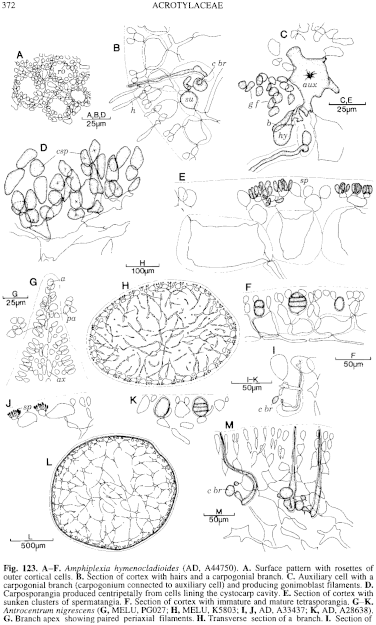|
|
|
|
|
|||||||||||
|
Electronic Flora of South Australia Species Fact Sheet
Phylum Rhodophyta – Class Florideophyceae – Order Gigartinales – Family Acrotylaceae
Selected citations: Kraft 1977a: 117, figs 7, 8, 15, 16. Papenfuss 1967: 102.
Synonyms
Bindera splachnoides Harvey 1859a: pl. 111 figs 5, 6 (NON figs 1–4).
Binderella neglecta Schmitz in Schmitz & Hauptfleisch 1897: 342, fig. 208G, H. Kylin 1931: 6, fig. 2A, B; 1956: 308, fig. 240A–D.
Champia circumcincta J. Agardh 1901: 26.
Thallus (Fig. 122A) medium to dark red-brown, 5–15 cm high, with elongate-clavate segments (1–) 2–5 cm long and 3–6 mm in diameter, with rounded apices and basally constricted, branching from near the apices and often from their upper half, developing a basal stalk 1–1.5 mm in diameter and up to 1 cm long. Holdfast crustose, knobby, 2–6 mm across, with one to a few fronds; epilithic. Structure multiaxial (Fig. 122B), developing a very lax filamentous, mucilage filled, medulla and a pseudoparenchymatous cortex with a single layer of large inner cells 25–50 om across, L/D 1–2, and a small-celled outer cortex 1–2 cells thick, outer cells ovoid, 4–8 µm in diameter, in surface view forming rosettes (Fig. 123A) around the margins of the large inner cells. Rhodoplasts laminate, 1–3 per outer cell.
Reproduction: Sexual thalli monoecious; procarpic. Carpogonial branches (Fig. 123B) borne singly on inner cortical cells, 3-celled, directed inwards with reflexed trichogynes. Supporting cell becoming the auxiliary cell (Fig. 123C), with a short connection from the fertilized carpogonium; nutritive filaments developed from adjacent vegetative cells and partly surrounding the auxiliary cell, with prominent enveloping tissue developing from vegetative cells and enlarging to form a cavity. Gonimoblast initials (Fig. 123C) developed thallus outwards, forming filaments which grow across the nutritive tissue and line the inner surface of the pericarp, then developing centripetally (Fig. 123D) in branched clusters and forming rows of 2–3 ovoid carposporangia (terminally mature) 10–15 µm in diameter. Cystocarps (Fig. 122C) protuberant, basally constricted, with enveloping tissue and outer thickened cortex, ostiolate. Spermatangial clusters (Fig. 123E) scattered, formed on mid cortical cells, with 3–4 initials each bearing 3–5 elongate-ovoid spermatangia 2–3 µm in diameter.
Tetrasporangia (Fig. 123F) developed from mid cortical cells (often bearing 2 outer cortical cells and thus intercalary), basally pit-connected, ovoid, 20–40 µm long and 15–25 µm in diameter, zonately divided.
Type from Port Phillip Heads, Vic. (Wilson); lectotype in Herb. Agardh, LD, 25737.
Selected specimens: Green I., Rottnest I., W. Aust., 18 m deep on crustose corallines (Kraft & Ricker, 4.xii.1980; MELU, K7621). Garden I., W. Aust. (Clifton; in Herb. Harvey, TCD). Pearson I., S. Aust., 15 m deep (Shepherd, 8.i.1969; AD, A33936). Stenhouse Bay, S. Aust., 3–7 m deep (Kraft, 18.ix.1973; AD, A44565). Investigator Strait, S. Aust., 31 m deep 35°28'S, 137°17'E (Watson, 23.i.1971; AD, A41107). Vivonne Bay, Kangaroo I., S. Aust., on jetty piles, 3–4 m deep (Latz, 22.xi.1968; AD, A33017 -"Marine Algae of southern Australia" No. 90) and 3–7 m deep (Kraft, 3.xii.1971; AD, A44750).
Distribution: Rottnest I., W. Aust., to Port Phillip Heads, Vic.
Taxonomic notes: The application of this name has been discussed by Kraft (1977a, p. 117). Amphiplexia hymenocladioides is a relatively rare alga, from shallow (probably shaded) situations to deep water.
References:
AGARDH, J.G. (1892). Analecta Algologica. Acta Univ. lund. 28, 1–182, Plates 1–3.
AGARDH, J.G. (1901). Species Genera et Ordines Algarum. Vol. 3, Part 4, pp. 1–149. (Gleerup: Lund.)
HARVEY, W.H. (1859a). Phycologia Australica. Vol. 2, Plates 61–120. (Reeve: London.)
KRAFT, G.T. (1977a). Studies of marine algae in the lesser-known families of the Gigartinales (Rhodophyta). I. The Acrotylaceae. Aust. J. Bot. 25, 97–140.
KYLIN, H. (1931). Die Florideenordnung Rhodymeniales. Lunds Univ. Årsskr. N.F. Avd. 2, 27 (11), 1–48, Plates 1–20.
KYLIN, H. (1956). Die Gattungen der Rhodophyceen. (Gleerups: Lund.)
PAPENFUSS, G.F. (1967). Notes on algal nomenclature. V. Various Chlorophyceae and Rhodophyceae. Phykos 5, 95–105.
SCHMITZ, F. & HAUPTFLEISCH, P. (1897). Gelidiaceae, Acrotylaceae, Gigartinaceae, Rhodophyllidaceae, Sphaerococcaceae, Rhodymeniaceae, pp. 340–405, Grateloupiaceae, Dumontiaceae, Nemastomaceae, Rhizophyllidaceae, Squamariaceae, pp. 508–537. In Engler, A. & Prantl, K., Die nattirlichen Pflanzenfamilien. T. 1. Abt. 2. (Engelmann: Leipzig.)
The Marine Benthic Flora of Southern Australia Part IIIA complete list of references.
Publication:
Womersley, H.B.S. (14 January, 1994)
The Marine Benthic Flora of Southern Australia
Rhodophyta. Part IIIA, Bangiophyceae and Florideophyceae (to Gigartinales)
Reproduced with permission from The Marine Benthic Flora of Southern Australia Part IIIA 1994, by H.B.S. Womersley. Australian Biological Resources Study, Canberra. Copyright Commonwealth of Australia.
Illustrations in Womersley Part IIIA, 1994: FIGS 122 A–C, 123 A–F.

Figure 122 enlarge
Fig. 122. A–C. Amphiplexia hymenocladioides (AD, A44750). A. Habit. B. Longitudinal section of a branch apex. C. Cross section of mature cystocarp. D, E. Amphiplexia racemosa (AD, A35852). D. Habit. E. Cross section of cystocarp, with ostiole. F. Antrocentrum nigrescens (AD, A48318). Habit. [B–E as in Kraft 1977a.]

Figure 123 enlarge
Fig. 123. A–F. Amphiplexia hymenocladioides (AD, A44750). A. Surface pattern with rosettes of outer cortical cells. B. Section of cortex with hairs and a carpogonial branch. C. Auxiliary cell with a carpogonial branch (carpogonium connected to auxiliary cell) and producing gonimoblast filaments. D. Carposporangia produced centripetally from cells lining the cystocarp cavity. E. Section of cortex with sunken clusters of spermatangia. F. Section of cortex with immature and mature tetrasporangia. G–K. Antrocentrum nigrescens (G, MELU, PG027; H, MELU, K5803; I, J, AD, A33437; K, AD, A28638). G. Branch apex showing paired periaxial filaments. H. Transverse section of a branch. I. Section of cortex with a 3-celled carpogonial branch. J. Section of cortex with spermatangia) clusters. K. Section of cortex with immature and mature tetrasporangia. L, M. Claviclonium ovatum (L, MELU, K6570; M, AD, A33615). L. Transverse section of a clavate lateral branch. M. Section of cortex with 3-celled carpogonial branches. [A–F after Kraft 1977a; G–M after Kraft & Min-Thein 1983.]

|
Email Contact: State Herbarium of South Australia |

|